《数据库系统概念 Database System Concepts》原书教学资源(第五版,PPT课件讲稿,英文版)Chapter 9 Object-Based Databases
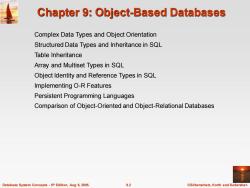
Chapter 9:Object-Based Databases Complex Data Types and Object Orientation Structured Data Types and Inheritance in SQL Table Inheritance Array and Multiset Types in SQL Object Identity and Reference Types in SQL Implementing O-R Features Persistent Programming Languages Comparison of Object-Oriented and Object-Relational Databases Database System Concepts-5th Edition,Aug 9,2005. 9.2 ©Silberschat乜,Korth and Sudarshan
Database System Concepts - 5 9.2 ©Silberschatz, Korth and Sudarshan th Edition, Aug 9, 2005. Chapter 9: Object-Based Databases Complex Data Types and Object Orientation Structured Data Types and Inheritance in SQL Table Inheritance Array and Multiset Types in SQL Object Identity and Reference Types in SQL Implementing O-R Features Persistent Programming Languages Comparison of Object-Oriented and Object-Relational Databases
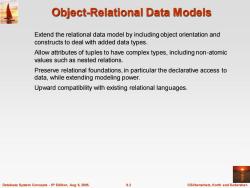
Object-Relational Data Models Extend the relational data model by including object orientation and constructs to deal with added data types. Allow attributes of tuples to have complex types,including non-atomic values such as nested relations. Preserve relational foundations,in particular the declarative access to data,while extending modeling power. Upward compatibility with existing relational languages. Database System Concepts-5th Edition,Aug 9,2005. 9.3 @Silberschatz,Korth and Sudarshan
Database System Concepts - 5 9.3 ©Silberschatz, Korth and Sudarshan th Edition, Aug 9, 2005. Object-Relational Data Models Extend the relational data model by including object orientation and constructs to deal with added data types. Allow attributes of tuples to have complex types, including non-atomic values such as nested relations. Preserve relational foundations, in particular the declarative access to data, while extending modeling power. Upward compatibility with existing relational languages
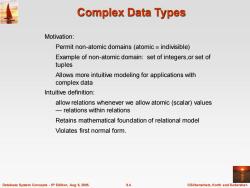
Complex Data Types Motivation: Permit non-atomic domains (atomic indivisible) Example of non-atomic domain:set of integers,or set of tuples Allows more intuitive modeling for applications with complex data Intuitive definition: allow relations whenever we allow atomic(scalar)values -relations within relations Retains mathematical foundation of relational model Violates first normal form. Database System Concepts-5th Edition,Aug 9,2005. 9.4 @Silberschatz,Korth and Sudarshan
Database System Concepts - 5 9.4 ©Silberschatz, Korth and Sudarshan th Edition, Aug 9, 2005. Complex Data Types Motivation: Permit non-atomic domains (atomic indivisible) Example of non-atomic domain: set of integers,or set of tuples Allows more intuitive modeling for applications with complex data Intuitive definition: allow relations whenever we allow atomic (scalar) values — relations within relations Retains mathematical foundation of relational model Violates first normal form
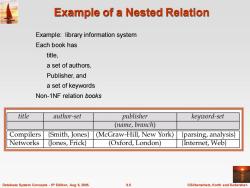
Example of a Nested Relation Example:library information system Each book has title, a set of authors, Publisher,and a set of keywords Non-1NF relation books title author-set publisher keyword-set (name,branch) Compilers (Smith,Jones) (McGraw-Hill,New York) [parsing,analysis) Networks Jones,Frick) (Oxford,London) (Internet,Web} Database System Concepts-5th Edition,Aug 9,2005. 9.5 ©Silberschat乜,Korth and Sudarshan
Database System Concepts - 5 9.5 ©Silberschatz, Korth and Sudarshan th Edition, Aug 9, 2005. Example of a Nested Relation Example: library information system Each book has title, a set of authors, Publisher, and a set of keywords Non-1NF relation books
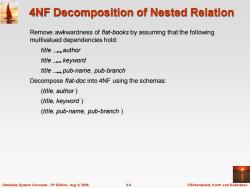
4NF Decomposition of Nested Relation Remove awkwardness of flat-books by assuming that the following multivalued dependencies hold: title _author title_keyword title pub-name,pub-branch Decompose flat-doc into 4NF using the schemas: (title,author) (title,keyword (title,pub-name,pub-branch Database System Concepts-5th Edition,Aug 9,2005. 9.6 @Silberschatz,Korth and Sudarshan
Database System Concepts - 5 9.6 ©Silberschatz, Korth and Sudarshan th Edition, Aug 9, 2005. 4NF Decomposition of Nested Relation Remove awkwardness of flat-books by assuming that the following multivalued dependencies hold: title author title keyword title pub-name, pub-branch Decompose flat-doc into 4NF using the schemas: (title, author ) (title, keyword ) (title, pub-name, pub-branch )

4NF Decomposition of flat-books title author title keyword Compilers Smith Compilers parsing Compilers Jones Compilers analysis Networks Jones Networks Internet Networks Frick Networks Web authors keywords title pub-name pub-branch Compilers McGraw-Hill New York Networks Oxford London books4 Database System Concepts-5th Edition,Aug 9,2005. 9.7 ©Silberschat乜,Korth and Sudarshan
Database System Concepts - 5 9.7 ©Silberschatz, Korth and Sudarshan th Edition, Aug 9, 2005. 4NF Decomposition of flat–books
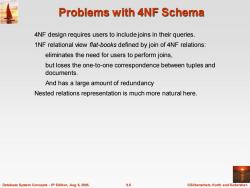
Problems with 4NF Schema 4NF design requires users to includejoins in their queries. 1NF relational view flat-books defined by join of 4NF relations: eliminates the need for users to perform joins, but loses the one-to-one correspondence between tuples and documents. And has a large amount of redundancy Nested relations representation is much more natural here. Database System Concepts-5th Edition,Aug 9,2005. 9.8 @Silberschatz,Korth and Sudarshan
Database System Concepts - 5 9.8 ©Silberschatz, Korth and Sudarshan th Edition, Aug 9, 2005. Problems with 4NF Schema 4NF design requires users to include joins in their queries. 1NF relational view flat-books defined by join of 4NF relations: eliminates the need for users to perform joins, but loses the one-to-one correspondence between tuples and documents. And has a large amount of redundancy Nested relations representation is much more natural here
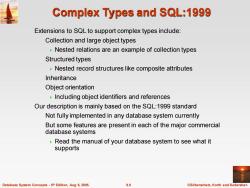
Complex Types and SQL:1999 Extensions to SQL to support complex types include: Collection and large object types Nested relations are an example of collection types Structured types Nested record structures like composite attributes Inheritance Object orientation Including object identifiers and references Our description is mainly based on the SQL:1999 standard Not fully implemented in any database system currently But some features are present in each of the major commercial database systems Read the manual of your database system to see what it supports Database System Concepts-5th Edition,Aug 9,2005. 9.9 ©Silberschat乜,Korth and Sudarshan
Database System Concepts - 5 9.9 ©Silberschatz, Korth and Sudarshan th Edition, Aug 9, 2005. Complex Types and SQL:1999 Extensions to SQL to support complex types include: Collection and large object types Nested relations are an example of collection types Structured types Nested record structures like composite attributes Inheritance Object orientation Including object identifiers and references Our description is mainly based on the SQL:1999 standard Not fully implemented in any database system currently But some features are present in each of the major commercial database systems Read the manual of your database system to see what it supports
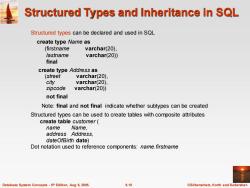
Structured Types and Inheritance in SQL Structured types can be declared and used in SQL create type Name as (firstname varchar(20), lastname varchar(20)) final create type Address as (street varchar(20), city varchar(20), zipcode varchar(20)) not final Note:final and not final indicate whether subtypes can be created Structured types can be used to create tables with composite attributes create table customer( name Name, addressAddress, dateOfBirth date) Dot notation used to reference components:name.firstname Database System Concepts-5th Edition,Aug 9,2005. 9.10 ©Silberschat乜,Korth and Sudarshan
Database System Concepts - 5 9.10 ©Silberschatz, Korth and Sudarshan th Edition, Aug 9, 2005. Structured Types and Inheritance in SQL Structured types can be declared and used in SQL create type Name as (firstname varchar(20), lastname varchar(20)) final create type Address as (street varchar(20), city varchar(20), zipcode varchar(20)) not final Note: final and not final indicate whether subtypes can be created Structured types can be used to create tables with composite attributes create table customer ( name Name, address Address, dateOfBirth date) Dot notation used to reference components: name.firstname

Structured Types (cont.) User-defined row types create type CustomerType as( name Name. address Address. dateOfBirth date) not final Can then create a table whose rows are a user-defined type create table customer of CustomerType Database System Concepts-5th Edition,Aug 9,2005. 9.11 @Silberschatz,Korth and Sudarshan
Database System Concepts - 5 9.11 ©Silberschatz, Korth and Sudarshan th Edition, Aug 9, 2005. Structured Types (cont.) User-defined row types create type CustomerType as ( name Name, address Address, dateOfBirth date) not final Can then create a table whose rows are a user-defined type create table customer of CustomerType
按次数下载不扣除下载券;
注册用户24小时内重复下载只扣除一次;
顺序:VIP每日次数-->可用次数-->下载券;
- 《数据库系统概念 Database System Concepts》原书教学资源(第五版,PPT课件讲稿,英文版)Chapter 8 Application Design and Development.ppt
- 《数据库系统概念 Database System Concepts》原书教学资源(第五版,PPT课件讲稿,英文版)Chapter 7 Relational Database Design.ppt
- 《数据库系统概念 Database System Concepts》原书教学资源(第五版,PPT课件讲稿,英文版)Chapter 6 Entity-Relationship Model.ppt
- 《数据库系统概念 Database System Concepts》原书教学资源(第五版,PPT课件讲稿,英文版)Chapter 5 Other Relational Languages.ppt
- 《数据库系统概念 Database System Concepts》原书教学资源(第五版,PPT课件讲稿,英文版)Chapter 4 Advanced SQL.ppt
- 《数据库系统概念 Database System Concepts》原书教学资源(第五版,PPT课件讲稿,英文版)Chapter 3 SQL.ppt
- 《数据库系统概念 Database System Concepts》原书教学资源(第五版,PPT课件讲稿,英文版)Chapter Advanced Transaction Processing.ppt
- 《数据库系统概念 Database System Concepts》原书教学资源(第五版,PPT课件讲稿,英文版)Chapter 24 Advanced Data Types.ppt
- 《数据库系统概念 Database System Concepts》原书教学资源(第五版,PPT课件讲稿,英文版)Chapter 23 Advanced Application Development.ppt
- 《数据库系统概念 Database System Concepts》原书教学资源(第五版,PPT课件讲稿,英文版)Chapter 22 Distributed Databases.ppt
- 《数据库系统概念 Database System Concepts》原书教学资源(第五版,PPT课件讲稿,英文版)Chapter 21 Parallel Databases.ppt
- 《数据库系统概念 Database System Concepts》原书教学资源(第五版,PPT课件讲稿,英文版)Chapter 20 Database System Architectures.ppt
- 《数据库系统概念 Database System Concepts》原书教学资源(第五版,PPT课件讲稿,英文版)Chapter 2 Relational Model.ppt
- 《数据库系统概念 Database System Concepts》原书教学资源(第五版,PPT课件讲稿,英文版)Chapter 19 Information Retrieval.ppt
- 《数据库系统概念 Database System Concepts》原书教学资源(第五版,PPT课件讲稿,英文版)Chapter 18 Data Analysis and Mining.ppt
- 《数据库系统概念 Database System Concepts》原书教学资源(第五版,PPT课件讲稿,英文版)Chapter 17 Recovery System.ppt
- 《数据库系统概念 Database System Concepts》原书教学资源(第五版,PPT课件讲稿,英文版)Chapter 16 Concurrency Control.ppt
- 《数据库系统概念 Database System Concepts》原书教学资源(第五版,PPT课件讲稿,英文版)Chapter 15 Transactions.ppt
- 《数据库系统概念 Database System Concepts》原书教学资源(第五版,PPT课件讲稿,英文版)Chapter 14 Query Optimization.ppt
- 《数据库系统概念 Database System Concepts》原书教学资源(第五版,PPT课件讲稿,英文版)Chapter 13 Query Processing.ppt
- 《数据库系统概念 Database System Concepts》原书教学资源(第七版,PPT课件讲稿,英文版)Chapter 01 Introduction(Avi Silberschatz Henry F. Korth S. Sudarshan).pptx
- 《数据库系统概念 Database System Concepts》原书教学资源(第七版,PPT课件讲稿,英文版)Chapter 10 Big Data.pptx
- 《数据库系统概念 Database System Concepts》原书教学资源(第七版,PPT课件讲稿,英文版)Chapter 11 Data Analytics.pptx
- 《数据库系统概念 Database System Concepts》原书教学资源(第七版,PPT课件讲稿,英文版)Chapter 12 Physical Storage Systems.pptx
- 《数据库系统概念 Database System Concepts》原书教学资源(第七版,PPT课件讲稿,英文版)Chapter 13 Data Storage Structures.pptx
- 《数据库系统概念 Database System Concepts》原书教学资源(第七版,PPT课件讲稿,英文版)Chapter 14 Indexing.pptx
- 《数据库系统概念 Database System Concepts》原书教学资源(第七版,PPT课件讲稿,英文版)Chapter 15 Query Processing.pptx
- 《数据库系统概念 Database System Concepts》原书教学资源(第七版,PPT课件讲稿,英文版)Chapter 16 Query Optimization.pptx
- 《数据库系统概念 Database System Concepts》原书教学资源(第七版,PPT课件讲稿,英文版)Chapter 17 Transactions.pptx
- 《数据库系统概念 Database System Concepts》原书教学资源(第七版,PPT课件讲稿,英文版)Chapter 18 Concurrency Control.pptx
- 《数据库系统概念 Database System Concepts》原书教学资源(第七版,PPT课件讲稿,英文版)Chapter 19 Recovery System.pptx
- 《数据库系统概念 Database System Concepts》原书教学资源(第七版,PPT课件讲稿,英文版)Chapter 02 Intro to Relational Model.pptx
- 《数据库系统概念 Database System Concepts》原书教学资源(第七版,PPT课件讲稿,英文版)Chapter 20 Database System Architectures.pptx
- 《数据库系统概念 Database System Concepts》原书教学资源(第七版,PPT课件讲稿,英文版)Chapter 21 Parallel and Distributed Storage.pptx
- 《数据库系统概念 Database System Concepts》原书教学资源(第七版,PPT课件讲稿,英文版)Chapter 22 Parallel and Distributed Query Processing.pptx
- 《数据库系统概念 Database System Concepts》原书教学资源(第七版,PPT课件讲稿,英文版)Chapter 23 Parallel and Distributed Transaction Processing.pptx
- 《数据库系统概念 Database System Concepts》原书教学资源(第七版,PPT课件讲稿,英文版)Chapter 24 Advanced Indexing.pptx
- 《数据库系统概念 Database System Concepts》原书教学资源(第七版,PPT课件讲稿,英文版)Chapter 25 Advanced Application Development.pptx
- 《数据库系统概念 Database System Concepts》原书教学资源(第七版,PPT课件讲稿,英文版)Chapter 26 Blockchain Databases.pptx
- 《数据库系统概念 Database System Concepts》原书教学资源(第七版,PPT课件讲稿,英文版)Chapter 27 Formal-Relational Query Languages.pptx
